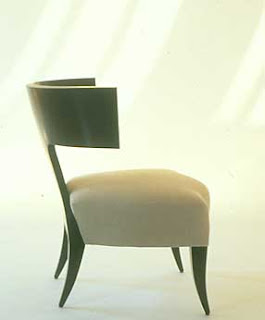The soft sweeping legs and curved crestrail of the klismos chair set it apart from most everything else the Ancient Greeks did. Their stools had harsh angles. Their stone thrones were cold and cumbersome. Their beds (klines) were simple. When it came to furniture, the ancient Greeks were about function and practicality.
The Greek house was unassuming, humble with limited decoration. The only place to sit was mainly on backless stools -- three and four legged stools, box stools, rectangular stools and folding stools.
But the Greeks, with their zeal for the human body, designed a particular chair that married beauty and comfort. Perfected by the fifth century BC and popular throughout the fourth, it echoed the rhythm and precision, clarity and proportion, and even order of their architecture. It was the most important creation in the history of the chair.
The klismos chair had grace, symmetry and perfect proportions.
No original klismos chairs reached modern times. It was made from wood which didn't survive through the times. But the Greeks left a rich history of bas reliefs and vase paintings of the chair.
The Greek house was unassuming, humble with limited decoration. The only place to sit was mainly on backless stools -- three and four legged stools, box stools, rectangular stools and folding stools.
But the Greeks, with their zeal for the human body, designed a particular chair that married beauty and comfort. Perfected by the fifth century BC and popular throughout the fourth, it echoed the rhythm and precision, clarity and proportion, and even order of their architecture. It was the most important creation in the history of the chair.
The klismos chair had grace, symmetry and perfect proportions.
No original klismos chairs reached modern times. It was made from wood which didn't survive through the times. But the Greeks left a rich history of bas reliefs and vase paintings of the chair.




Homer even said "Goddesses liked the klismos". And interestingly enough, primarily women were the ones who sat in this chair. Bouncing babies on their knees, spinning thread or getting their hair braided.
The klismos chair was forgotten until the excavations at Pompeii and Herculaneum in the mid-eighteenth century created a frenzy of design and a fad for all things Grecian (and Roman). The clean lines matched very well with the neoclassical style. It France it appealed to those who reacted against the excessive, whimsical rococo style. In England the klismos became popular during the Regency period of the early nineteenth century. And it soon made its way to America.
So what do we think? Is this a chair we would like to incorporate into our own homes? Which style, which era and in which finish? As a set or for single use quietly paired with a desk in the corner of a room.
The klismos chair was forgotten until the excavations at Pompeii and Herculaneum in the mid-eighteenth century created a frenzy of design and a fad for all things Grecian (and Roman). The clean lines matched very well with the neoclassical style. It France it appealed to those who reacted against the excessive, whimsical rococo style. In England the klismos became popular during the Regency period of the early nineteenth century. And it soon made its way to America.
So what do we think? Is this a chair we would like to incorporate into our own homes? Which style, which era and in which finish? As a set or for single use quietly paired with a desk in the corner of a room.

Klismos Chair, by James Newton (1760-1829). Made from mahogany with modern leather upholstery. London, England, circa 1805. V & A Museum.

Architect Benjamin Latrobe designed a suite of Greek style furniture for the White House. This Federal chair is just one of a set of nine. It has curved sabra legs of the Grecian klismos chair but the turned front legs borrowed from the Romans. MET Museum.
Three different finishes on the klismos chair by the legendary Terence Harold Robsjohn-Gibbings. Which finish is most preferable?

Klismos chair of 1937 at the MET Museum

Brooklyn Museum has a walnut version created in 1961.
 Bleached wood version at JF Chen.
Bleached wood version at JF Chen. A pair of nineteenth century Swedish klismos chairs Antique Art & Exchange.
A pair of nineteenth century Swedish klismos chairs Antique Art & Exchange.
French Consulat Style Chairs circa 1930 available at Trianon Antiques.

Donghia's version?

Pair of contemporary klismos chairs in Gustavian Style copied after Swedish klismos armchairs of the early nineteenth century. Available at Burden and Izett on 1stdibs.
 Kreiss - Klismos Side Chair - in rattan, leather and iron. Does the material work with the form of this chair?
Kreiss - Klismos Side Chair - in rattan, leather and iron. Does the material work with the form of this chair?


